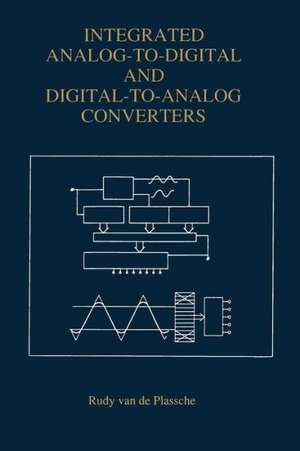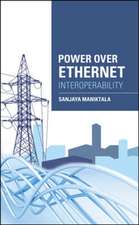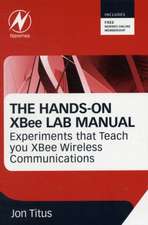Integrated Analog-To-Digital and Digital-To-Analog Converters: The Springer International Series in Engineering and Computer Science, cartea 264
Autor Rudy J. van de Plasscheen Limba Engleză Paperback – 5 noi 2012
Integrated Analog-to-Digital and Digital-to-Analog Converters describes in depth the theory behind and the practical design of these circuits. It describes the different techniques to improve the accuracy in high-resolution A/D and D/A converters and also special techniques to reduce the number of elements in high-speed A/D converters by repetitive use of comparators.
Integrated Analog-to-Digital and Digital-to-Analog Converters is the most comprehensive book available on the subject. Starting from the basic elements of theory necessary for a complete understanding of the design of A/D and D/A converters, this book describes the design of high-speed A/D converters, high-accuracy D/A and A/D converters, sample-and-hold amplifiers, voltage and current reference sources, noise-shaping coding and sigma-delta converters.
Integrated Analog-to-Digital and Digital-to-Analog Converters contains a comprehensive bibliography and index and also includes a complete set of problems. This book is ideal for use in an advanced course on the subject and is an essential reference for researchers and practicing engineers.
Din seria The Springer International Series in Engineering and Computer Science
- 24%
 Preț: 1041.98 lei
Preț: 1041.98 lei - 20%
 Preț: 643.50 lei
Preț: 643.50 lei - 18%
 Preț: 1225.62 lei
Preț: 1225.62 lei - 18%
 Preț: 965.02 lei
Preț: 965.02 lei - 20%
 Preț: 646.12 lei
Preț: 646.12 lei - 18%
 Preț: 948.79 lei
Preț: 948.79 lei - 20%
 Preț: 646.62 lei
Preț: 646.62 lei - 15%
 Preț: 637.46 lei
Preț: 637.46 lei - 20%
 Preț: 643.83 lei
Preț: 643.83 lei - 18%
 Preț: 949.23 lei
Preț: 949.23 lei - 20%
 Preț: 644.48 lei
Preț: 644.48 lei - 20%
 Preț: 994.92 lei
Preț: 994.92 lei - 20%
 Preț: 645.97 lei
Preț: 645.97 lei - 18%
 Preț: 946.87 lei
Preț: 946.87 lei - 20%
 Preț: 995.57 lei
Preț: 995.57 lei - 18%
 Preț: 956.99 lei
Preț: 956.99 lei - 20%
 Preț: 644.98 lei
Preț: 644.98 lei - 15%
 Preț: 649.54 lei
Preț: 649.54 lei - 18%
 Preț: 950.21 lei
Preț: 950.21 lei - 18%
 Preț: 1221.38 lei
Preț: 1221.38 lei - 18%
 Preț: 957.62 lei
Preț: 957.62 lei - 15%
 Preț: 643.99 lei
Preț: 643.99 lei - 18%
 Preț: 948.47 lei
Preț: 948.47 lei - 18%
 Preț: 947.35 lei
Preț: 947.35 lei - 20%
 Preț: 1284.65 lei
Preț: 1284.65 lei - 20%
 Preț: 1628.31 lei
Preț: 1628.31 lei - 20%
 Preț: 1285.78 lei
Preț: 1285.78 lei
Preț: 402.56 lei
Nou
Puncte Express: 604
Preț estimativ în valută:
77.03€ • 82.37$ • 64.23£
77.03€ • 82.37$ • 64.23£
Carte tipărită la comandă
Livrare economică 18 aprilie-02 mai
Preluare comenzi: 021 569.72.76
Specificații
ISBN-13: 9781461361862
ISBN-10: 1461361869
Pagini: 548
Ilustrații: XLIV, 501 p.
Dimensiuni: 160 x 240 x 32 mm
Greutate: 0.76 kg
Ediția:Softcover reprint of the original 1st ed. 1994
Editura: Springer Us
Colecția Springer
Seria The Springer International Series in Engineering and Computer Science
Locul publicării:New York, NY, United States
ISBN-10: 1461361869
Pagini: 548
Ilustrații: XLIV, 501 p.
Dimensiuni: 160 x 240 x 32 mm
Greutate: 0.76 kg
Ediția:Softcover reprint of the original 1st ed. 1994
Editura: Springer Us
Colecția Springer
Seria The Springer International Series in Engineering and Computer Science
Locul publicării:New York, NY, United States
Public țintă
ResearchCuprins
1 The converter as a black box.- 1.1 Introduction.- 1.2 Basic D/A and A/D converter function.- 1.3 Classification of signals.- 1.4 Sampling time uncertainty.- 1.5 Sampling clock time uncertainty.- 1.6 Quantization errors.- 1.7 Oversampling of converters.- 1.8 Quantizer model.- 1.9 Filtering.- 1.10 Minimum required stop band attenuation.- 1.11 Conclusion.- 2 Specifications of converters.- 2.1 Introduction.- 2.2 Digital data coding.- 2.3 Digital coding schemes.- 2.4 DC specifications.- 2.5 Dynamic specifications.- 2.6 Conclusion.- 3 Testing of D/A and A/D converters.- 3.1 Introduction.- 3.2 DC testing of D/A converters.- 3.3 Dynamic testing of D/A converters.- 3.4 DC testing of A/D converters.- 3.5 Dynamic testing of A/D converters.- 3.6 Bit Error Rate.- 3.7 Testing very high-speed A/D converters.- 3.8 Beat frequency test configuration.- 3.9 Code density DNL and INL measurement.- 3.10 Testing of sample-and-hold amplifiers.- 3.11 Cascading sample-and-hold amplifiers.- 3.12 Conclusion.- 4High-speed A/D converters.- 4.1 Introduction.- 4.2 Design problems in high-speed converters.- 4.3 Internal converter coding schemes.- 4.4 Full-flash converters.- 4.5 Gray code full flash converters.- 4.6 Circular code flash converters.- 4.7 Two-step flash converters.- 4.8 Multi-step A/D converter.- 4.9 Folding A/D converters.- 4.10 Double folding system.- 4.11 Folding and interpolation systems.- 5 Limitations of comparators.- 5.1 Signal delay in limiting amplifiers.- 5.2 Definition of the delay problem.- 5.3 Delay calculation model.- 5.4 Variable delay calculation.- 5.5 Distortion calculation.- 5.6 Failure analysis of comparators.- 5.7 Input frequency decision moment variation.- 5.8 Conclusion.- 6 High-accuracy D/A converters.- 6.1 Introduction.- 6.2 Pulse-width modulation D/A converters.- 6.3 Integrating D/A converters.- 6.4 Current weighting using ladder networks.- 6.5 Monotonic by design network systems.- 6.6 Self calibrating D/A converter system.- 6.7 Dynamic Element Matching.- 6.8Current calibration principle.- 6.9 Conclusion.- 7 High-accuracy A/D converters.- 7.1 Introduction.- 7.2 Single slope A/D converter system.- 7.3 Dual-slope A/D converter system.- 7.4 Dual-ramp single-slope A/D converter system.- 7.5 Successive approximation converter system.- 7.6 Algorithmic A/D converter.- 7.7 Cyclic Redundant Signed Digit A/D converter.- 7.8 Self-calibrating capacitor A/D converter.- 7.9 Conclusion.- 8 Sample-and-hold amplifiers.- 8.1 Introduction.- 8.2 Basic sample-and-hold configuration.- 8.3 Generalized non-inverting configurations.- 8.4 Generalized inverting configurations.- 8.5 Differential sample-and-hold configurations.- 8.6 Bipolar inverting mode S/H example.- 8.7 Conclusion.- 9 Voltage and current reference sources.- 9.1 Introduction.- 9.2 Zener diode reference voltage.- 9.3 Base-emitter voltage used as a reference.- 9.4 All-NPN band-gap voltage reference source.- 9.5 General purpose current stabilizer.- 9.6 Basic band-gap reference voltage source.- 9.7 Band-gap reference current source.- 9.8 Noise of a band-gap reference current source.- 9.9 Conclusion.- 10 Noise-shaping coding.- 10.1 Introduction.- 10.2 Digital oversampling filtering.- 10.3 Noise-shaping coders.- 10.4 Multi-bit largely oversampled noise-shaper.- 10.5 Stability analysis of noise-shapers.- 10.6 Practical noise-shaping D/A converters.- 10.7 Multi-bit noise-shaping D/A converter.- 10.8 Conclusion.- 11 Sigma-delta converters.- 11.1 Introduction.- 11.2 General form of Sigma-delta A/D converters.- 11.3 First-order A/D converter.- 11.4 Second-order A/D converter.- 11.5 Third-order A/D converter.- 11.6 Multi-stage sigma-delta converter (MASH).- 11.7 Feed-forward A/D converter system.- 11.8 Nth-order sigma-delta architecture.- 11.9 Idle pattern.- 11.10 Sigma-delta digital voltmeter.- 11.11 Conclusion.- Problems 453.- Bibliography 465.
















